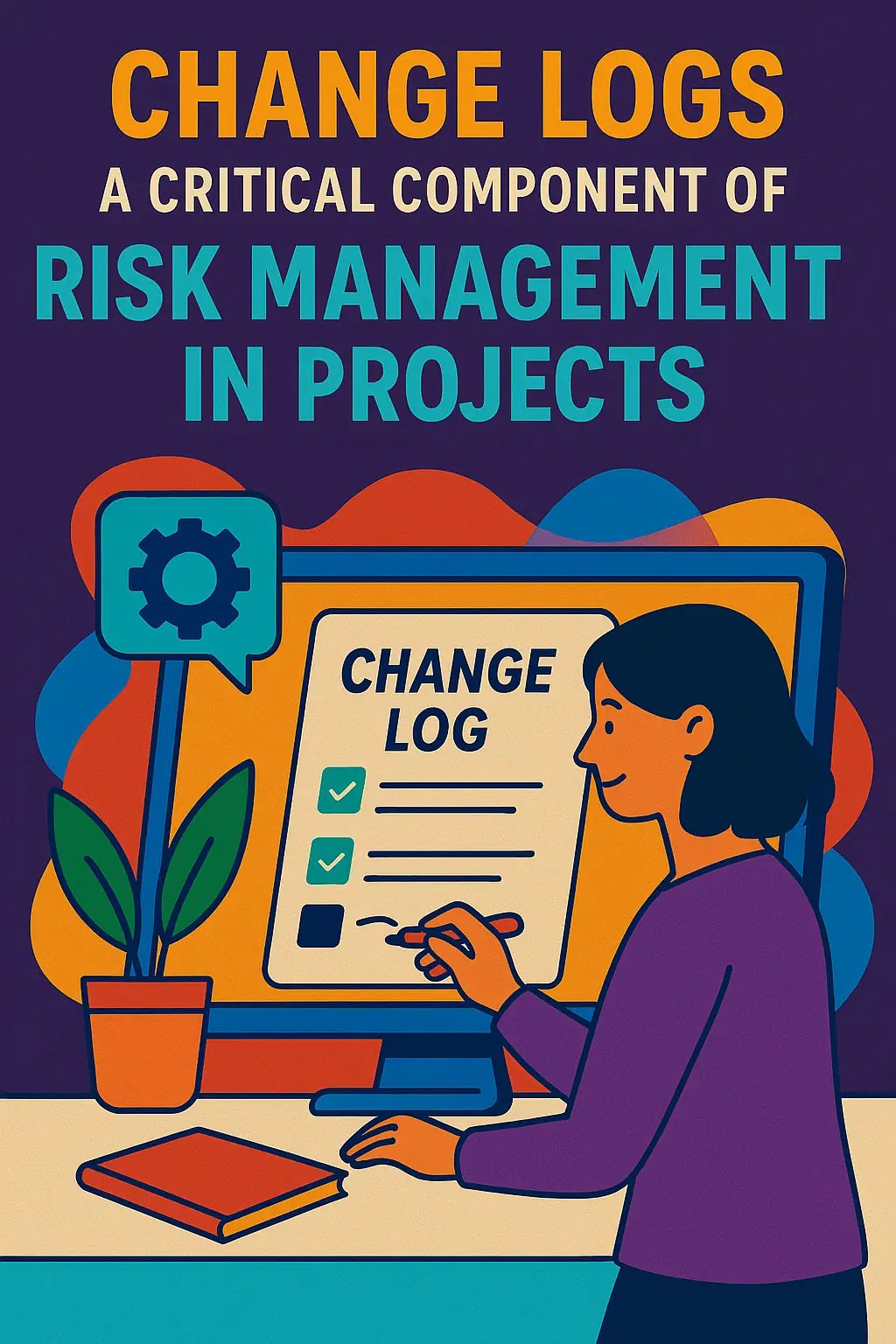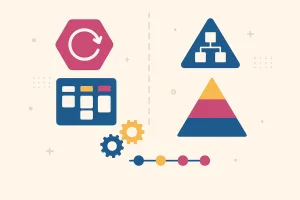Introduction to Change Logs
Change logs serve as a vital tool for documenting alterations made throughout the project lifecycle. A change log is essentially a structured record that captures all modifications, updates, or additions to a project’s scope, schedule, budget, or other critical components. This documentation is crucial for maintaining clarity and transparency among project stakeholders, ensuring that everyone is informed about the changes that occur during the project [12][15].
The importance of change logs extends beyond mere record-keeping; they play a significant role in effective risk management strategies. By systematically tracking changes, project teams can identify potential risks associated with those modifications. This proactive approach allows risk managers and project planners to assess the impact of changes on project objectives, timelines, and budgets, thereby minimizing adverse effects and enhancing project outcomes [4][8].
For risk managers and project planners, understanding and utilizing change logs is essential. These professionals rely on accurate and up-to-date information to make informed decisions, manage stakeholder expectations, and mitigate risks effectively. A well-maintained change log not only aids in tracking project changes but also serves as a reference point for evaluating the implications of those changes on overall project risk [3][5].
Understanding Risk Management in Projects
Risk management is a fundamental aspect of project management that involves identifying, analyzing, and responding to potential risks that could impact a project’s success. It is a systematic process that helps project teams minimize the adverse effects of risks while maximizing opportunities. The significance of risk management in project success cannot be overstated, as it directly influences the project’s ability to meet its objectives, stay within budget, and adhere to timelines.
Definition of Risk Management and Its Significance in Project Success
Risk management is defined as the process of identifying, analyzing, and responding to risks throughout the life cycle of a project. This process is crucial because it allows project managers to foresee potential challenges and develop strategies to mitigate them before they escalate into significant issues. Effective risk management contributes to project success by:
- Enhancing Decision-Making: By understanding potential risks, project managers can make informed decisions that align with project goals and stakeholder expectations [7].
- Increasing Project Resilience: A robust risk management strategy prepares teams to handle unforeseen challenges, thereby increasing the likelihood of project completion on time and within budget [14].
- Supporting Timely Responses: With a clear risk management plan, teams can respond quickly to emerging risks, reducing their impact on project deliverables [14].
Key Components of Effective Risk Management Strategies
An effective risk management strategy encompasses several key components that work together to create a comprehensive approach to managing risks:
- Risk Identification: This initial step involves recognizing potential risks that could affect the project. It is essential to engage stakeholders and utilize various techniques to ensure a thorough identification process [12].
- Risk Assessment: Once risks are identified, they must be analyzed to evaluate their potential impact and likelihood. This assessment can be qualitative or quantitative, helping teams prioritize risks based on their severity [3].
- Risk Response Planning: After assessing risks, project teams must develop strategies to address them. This may include risk avoidance, mitigation, transfer, or acceptance, depending on the nature of the risk and its potential impact on the project [15].
- Ongoing Monitoring and Review: Effective risk management is not a one-time task; it requires continuous monitoring and reassessment of risks throughout the project lifecycle. This ensures that the risk management strategies remain relevant and effective as the project evolves [11].
The Relationship Between Risk Identification, Assessment, and Response Planning
The relationship between risk identification, assessment, and response planning is integral to the overall risk management process. Each component feeds into the next, creating a cycle of continuous improvement:
- Risk Identification lays the groundwork for understanding what could go wrong in a project. Without identifying risks, teams cannot assess their potential impact or develop appropriate responses [12].
- Risk Assessment provides the necessary context for response planning. By understanding the likelihood and consequences of identified risks, project managers can prioritize their responses and allocate resources effectively [3].
- Response Planning is informed by both the identification and assessment phases. The strategies developed during this phase are tailored to the specific risks identified and assessed, ensuring that the project is equipped to handle potential challenges effectively [15].
The Role of Change Logs in Risk Management
Change logs serve as a vital tool in project management, particularly in the context of risk management strategies. They provide a structured way to document alterations that can significantly impact various aspects of a project, including its scope, schedule, and resources. Here’s how change logs contribute to effective risk management:
- Documentation of Changes: Change logs meticulously record all modifications made during the project lifecycle. This includes details such as the nature of the change, the date it was implemented, and the individuals responsible for it. By maintaining a comprehensive record, project managers can better understand how these changes may affect the project’s overall trajectory and resource allocation [10][12].
- Identifying Risks from Changes: Certain changes can introduce risks that may jeopardize project success. For instance, scope creep—the gradual expansion of project scope without corresponding adjustments in resources or timelines—can lead to significant delays and budget overruns. Similarly, changes in stakeholder involvement or expectations can create misalignments that pose risks to project objectives. By documenting these changes in a change log, project managers can identify potential risks early and develop strategies to address them [14][15].
- Timely Updates for Risk Mitigation: The effectiveness of a change log hinges on its timely updates. Regularly updating the change log ensures that all team members and stakeholders are aware of the latest developments, which is crucial for effective risk mitigation. When changes are documented promptly, project managers can assess their implications and implement necessary adjustments to minimize adverse effects. This proactive approach helps in maintaining project alignment with its goals and reduces the likelihood of unforeseen challenges arising from untracked changes [6][14].
Linking Change Logs to Risk Assessment
Change logs play a pivotal role in project management, particularly in the context of risk management. By systematically documenting changes made throughout a project, change logs provide valuable data that can enhance risk analysis and prioritization. Here’s how change logs can be effectively linked to risk assessment processes:
How Change Logs Provide Data for Risk Analysis and Prioritization
- Documentation of Changes: Change logs serve as a comprehensive record of all modifications, including scope alterations, schedule adjustments, and budget revisions. This documentation is crucial for identifying potential risks that may arise from these changes, as each modification can introduce new uncertainties or exacerbate existing ones [10][14].
- Historical Context: By analyzing past changes recorded in the change log, project managers can identify patterns or recurring issues that may indicate underlying risks. For instance, frequent changes in project scope could signal a lack of clarity in project requirements, which is a risk that needs to be addressed [12][14].
- Impact Assessment: Each entry in a change log typically includes an assessment of the impact of the change on the project. This information can be directly utilized in risk assessments to evaluate how changes might affect project objectives, timelines, and costs, allowing for more informed prioritization of risks [11][14].
Methods for Integrating Change Log Data with Risk Assessment Tools
- Risk Register Updates: Integrating change log data into the risk register can enhance the accuracy of risk assessments. By updating the risk register with insights from the change log, project managers can ensure that all relevant risks are captured and monitored effectively [9][8].
- Automated Tools: Utilizing project management software that allows for the integration of change logs with risk assessment tools can streamline the process. These tools can automatically flag changes that may impact risk levels, providing real-time insights and facilitating proactive risk management [5][8].
- Regular Reviews: Establishing a routine for reviewing change logs in conjunction with risk assessments can help teams stay ahead of potential issues. Regularly scheduled meetings to discuss changes and their implications for risk can foster a culture of proactive risk management [6][8].
Case Studies or Examples Where Change Logs Informed Risk Assessments
- Construction Project: In a large-scale construction project, the project team maintained a detailed change log that documented all alterations to the original plan. When a significant change in materials was proposed, the team used the change log to assess the potential risks associated with delays in delivery and increased costs. This proactive approach allowed them to implement mitigation strategies before the changes were finalized, ultimately saving time and resources [4][8].
- Software Development: A software development team utilized a change log to track feature updates and bug fixes. By analyzing the change log, they identified a pattern of recurring bugs related to a specific feature. This insight prompted a risk assessment that led to a redesign of the feature, significantly reducing the risk of future issues and improving overall project quality [3][9].
Best Practices for Maintaining Change Logs
Change logs are essential in project management, particularly in the context of risk management. They not only document changes but also facilitate effective communication and collaboration among project stakeholders. Here are some best practices for maintaining change logs that can enhance risk management strategies:
- Establish a Standardized Process for Documenting Changes: A robust change management process is crucial for effectively managing changes within a project. This process should be tailored to the project’s size and complexity, ensuring that it meets the needs of all stakeholders involved. By having a clear and standardized method for documenting changes, project teams can minimize confusion and ensure that all modifications are tracked systematically [2][12].
- Ensure Consistent Communication Among Project Team Members: Regular communication is vital for keeping all team members informed about changes and updates. Establishing routine meetings to review the change log can help ensure that everyone is on the same page. This practice not only promotes transparency but also encourages team members to report any new risks or issues that may arise as a result of changes [8][11]. By fostering an environment of open communication, teams can better manage risks and respond proactively to potential challenges.
- Utilize Technology and Tools to Automate and Streamline Change Log Management: Leveraging technology can significantly enhance the efficiency of change log management. Various project management tools and software can automate the documentation process, making it easier to track changes and updates in real-time. This automation reduces the administrative burden on project managers and allows them to focus on strategic risk management activities. Additionally, these tools often provide features for collaboration, ensuring that all team members can access and contribute to the change log seamlessly [3][10].
By implementing these best practices, project managers and risk managers can ensure that change logs serve as a powerful tool in their risk management arsenal, ultimately leading to more successful project outcomes.
Real-World Examples of Change Logs in Action
Change logs play a pivotal role in project management, particularly in the realm of risk management. By documenting changes meticulously, project teams can better anticipate, mitigate, and respond to risks. Here are some concrete examples that illustrate the effectiveness of change logs in managing project risks, as well as insights from projects that faced challenges due to inadequate change log management.
Case Studies Showcasing Successful Projects
- IT Project Implementation at a Fortune 500 Company: A major IT project at a Fortune 500 company utilized a comprehensive change log to track modifications in project scope and timelines. By maintaining detailed records of changes, the project team was able to identify potential risks early, allowing them to implement mitigation strategies effectively. This proactive approach led to the project being completed on time and within budget, demonstrating how a well-maintained change log can enhance risk management efforts [6].
- Construction Project in Urban Development: In a large urban development project, the project manager implemented a change log to document all alterations in design and materials. This log was crucial in managing risks associated with regulatory compliance and stakeholder expectations. By referencing the change log during risk assessments, the team was able to address concerns promptly, resulting in a successful project delivery with minimal disruptions [5].
Analysis of Projects with Inadequate Change Log Management
- Software Development Project Failure: A software development project faced significant setbacks due to poor change log management. The team failed to document changes in requirements adequately, leading to confusion and miscommunication among stakeholders. As a result, the project experienced scope creep and missed deadlines, ultimately resulting in a failed launch. This case highlights the critical importance of maintaining an accurate change log to avoid misunderstandings and manage risks effectively [4].
- Manufacturing Process Overhaul: In a manufacturing company, a change log was not utilized during a process overhaul, leading to untracked modifications in production methods. The lack of documentation resulted in quality control issues and increased operational risks. The project ultimately incurred additional costs and delays, underscoring the necessity of a structured change log to monitor and manage risks associated with process changes [3].
Lessons Learned from Real-World Situations
- Proactive Risk Identification: Projects that effectively used change logs were able to identify risks proactively. By documenting changes, teams could analyze their potential impact on project objectives, allowing for timely interventions [1][2].
- Enhanced Communication: Change logs serve as a communication tool among stakeholders. Projects that maintained clear and updated logs fostered better collaboration and understanding, which is essential for effective risk management [6].
- Continuous Improvement: The experiences from projects that suffered due to inadequate change log management emphasize the need for continuous improvement in documentation practices. Regularly reviewing and updating change logs can help teams learn from past mistakes and refine their risk management strategies [5][4].
Conclusion: Integrating Change Logs into Risk Management Frameworks
Change logs play an indispensable role in enhancing risk management practices. They serve as a centralized repository for documenting all changes made throughout the project lifecycle, which is crucial for maintaining transparency and accountability. By systematically recording changes, project managers can better understand the implications of these modifications on project risks, thereby facilitating more informed decision-making. This proactive approach allows teams to identify potential risks associated with changes early on, enabling them to devise effective mitigation strategies before issues escalate.
Moreover, integrating change logs into risk management frameworks fosters a culture of continuous improvement. By regularly reviewing and updating change logs, project managers and risk managers can identify patterns and trends that may indicate underlying risks. This ongoing analysis not only aids in the timely resolution of issues but also enhances the overall resilience of the project against unforeseen challenges.
It is essential for project managers and risk managers to prioritize the integration of change logs into their risk management strategies. By doing so, they can ensure that all stakeholders are aligned and informed about the project’s evolution, which is vital for maintaining stakeholder engagement and trust.
Find out more about Shaun Stoltz https://www.shaunstoltz.com/about/.
This post was written by an AI and reviewed/edited by a human.



